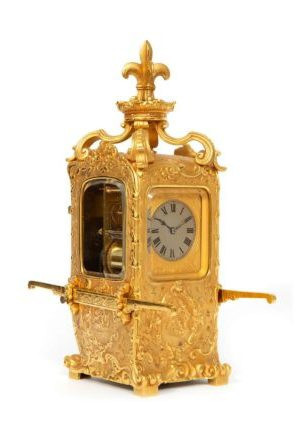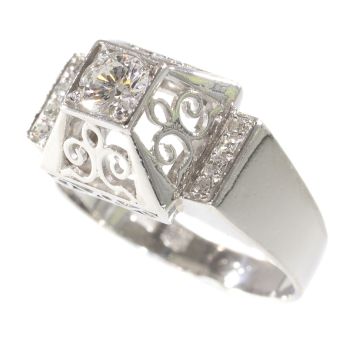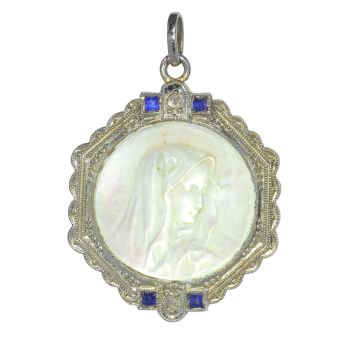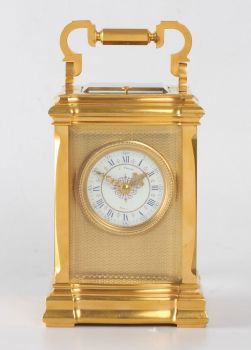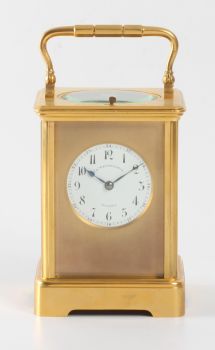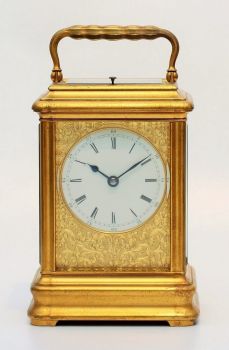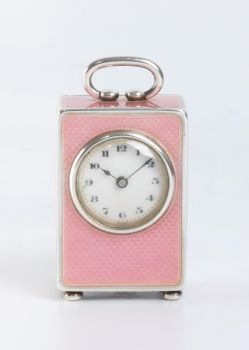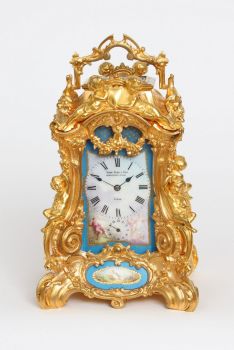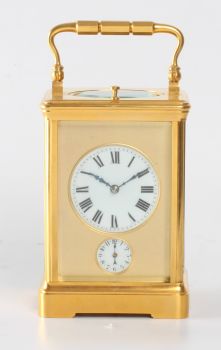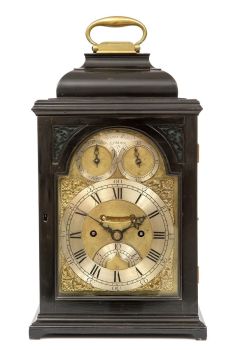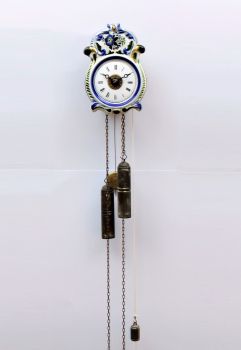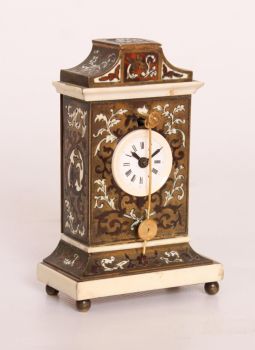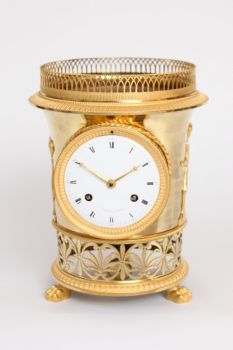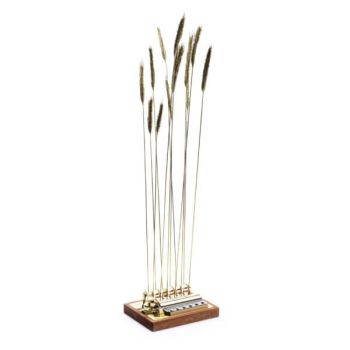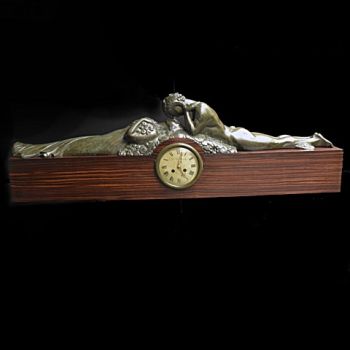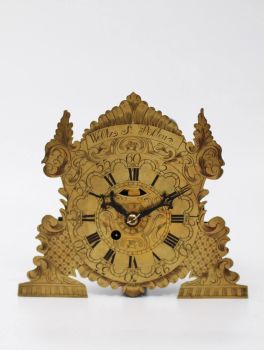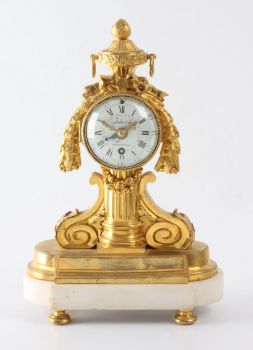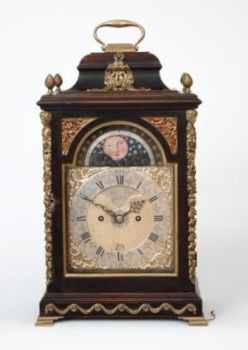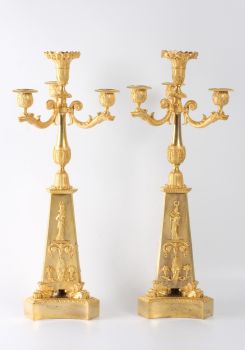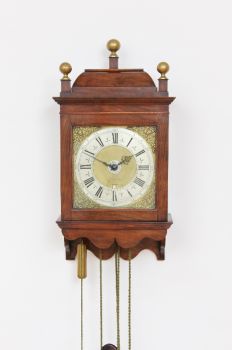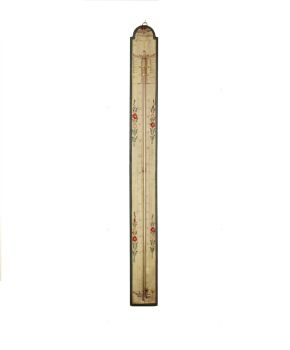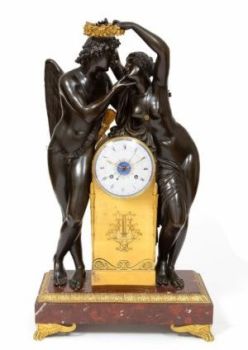A French gilt brass 'sedan chair' carriage clock, circa 1870 1870
Artista Desconocido
28 ⨯ 11 ⨯ 21 cm
€ 12.500
Gude & Meis Antique clocks and Music Boxes
- Sobre la obra de arteThe case
The cast and chiseled gilt bronze case is shaped as a 'sedan chair' from the 18th Century. It is surmounted by a fleur-des-lys ornament and adourned by foliate scrolls and flowers around cartouches with putti all over. It has carrying bars on the sides and is raised on scroll feet.
The dial
The 4.6-cm silvered dial has Roman numerals and has blued steel fleur-des-lys hands. It is set in a finely foliate engraved gilt mask.
The movement
The spring driven movement has a duration of eight days. It strikes the hours and half hours on a coiled steel gong. It is regulated by a platform anchor escapement.
a display of fantasy
French carriage clockmakers sought to improve their sales by producing different cases. First, there were different styles of cases such as the ‘gorge case’ or ‘case Anglaise’. Later cases were embellished with porcelain panels or colourful enamel. But certainly one of the most imaginative carriage clocks is this one shaped as a sedan chair. Of course, it is very unlikely that this clock was used during travel, but that could also be said of other so-called carriage clocks having vulnerable porcelain panels. It does show the ingenuity of the makers, though, and the lengths they went to find new buyers. This beautifully made object is a curiosity that will amaze and bring delight to many that see it.
Lit. Derek Roberts, Carriage and other travelling clocks, pp. 115. - Sobre el artista
Puede suceder que un artista o creador sea desconocido.
Algunas obras no deben determinarse por quién está hecho o por (un grupo de) artesanos. Algunos ejemplos son estatuas de la Antigüedad, muebles, espejos o firmas que no son claras o legibles, pero también algunas obras no están firmadas en absoluto.
También puedes encontrar la siguiente descripción:
•"Atribuido a …." En su opinión, probablemente una obra del artista, al menos en parte.
•“Estudio de….” o “Taller de” En su opinión, una obra ejecutada en el estudio o taller del artista, posiblemente bajo su supervisión
•“Círculo de…” En su opinión, una obra del período del artista que muestra su influencia, estrechamente asociado con el artista pero no necesariamente su alumno.
•"Estilo de …." o “Seguidor de…”. En su opinión, una obra ejecutada al estilo del artista pero no necesariamente por un alumno; puede ser contemporáneo o casi contemporáneo
•"Manera de …." En su opinión una obra al estilo del artista pero de fecha posterior
•"Después …." En su opinión, una copia (de cualquier fecha) de una obra del artista
•“Firmado…”, “Fechado…” o “Inscrito” En su opinión, la obra ha sido firmada/fechada/inscrita por el artista. La adición de un signo de interrogación indica un elemento de duda.
•“Con firma…”, “Con fecha…”, “Con inscripción…” o “Lleva firma/fecha/inscripción” en su opinión la firma/fecha/inscripción ha sido añadida por alguien que no es el artista
¿Está interesado en comprar esta obra de arte?
Artwork details
Related artworks
- 1 - 4 / 12
Firm Erhard & Sohne, Schwäbisch Gmünd
Erhard und Söhne – Jugendstil intarsia klok – 1908 / 19091900 - 1909
Precio a consultarAntiques Emporium
1 - 4 / 24- 1 - 4 / 12

